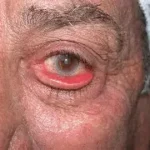Eyelid Conditions
Eyelid conditions are common and can affect both comfort and vision. The eyelids play an essential role in protecting the eye, spreading tears, and maintaining a healthy ocular surface. When problems develop, patients often experience irritation, redness, eyelash changes, or vision disturbances. Below is an overview of the most common eyelid issues, including ptosis and Demodex blepharitis.
Blepharitis
Blepharitis refers to inflammation of the eyelid margins. It can be associated with bacteria, clogged oil glands, or skin conditions such as rosacea. Symptoms often include:

- Red, irritated eyelids
- Crusting around the lashes
-
Burning or gritty sensation
- Fluctuating vision
Demodex Blepharitis
Demodex mites are a common cause of chronic blepharitis and are often identified by cylindrical dandruff at the base of the lashes.
Treatment with XDEMVY (lotilaner ophthalmic solution 0.25%) XDEMVY is an FDA‑approved prescription eye drop used to treat Demodex blepharitis. It targets the mites directly and helps reduce inflammation, debris, and eyelash irritation. Many patients experience improvement in symptoms and eyelid appearance following a full treatment course.
Ptosis (Droopy Eyelid)
Ptosis occurs when the upper eyelid droops lower than normal. It may affect one or both eyes and can range from mild to severe. Causes include age-related muscle stretching, nerve problems, previous eye surgery, or congenital factors.
Common symptoms of ptosis:
- Drooping lid noticeable in photos or mirrors

- Fatigue of the forehead from trying to lift the brow
- Blocked or partially blocked vision
- Needing to tilt the head back to see clearly
Treatment Options Ptosis is typically corrected surgically by tightening or reattaching the eyelid elevating muscle. This outpatient procedure can significantly improve both vision and appearance. If you have new onset ptosis, an exam to rule out neurologic causes such as Horner's syndrome and myasthenia gravis is recommended.
Chalazion and Stye

Stye (Hordeolum)
A stye is an acute infection of an eyelash follicle or oil gland, causing a painful, red bump.
Chalazion
A chalazion is a noninfectious, painless bump caused by a blocked oil gland. It may persist for weeks to months.
Treatment Options: Warm compresses, lid hygiene, topical medications, steroid injections, or minor in‑office procedures when needed.
Ectropion and Entropion
Ectropion
The eyelid turns outward, leading to exposure, tearing, and irritation.
Entropion
The eyelid turns inward, causing lashes to rub against the eye.
Both conditions can cause chronic tearing, redness, and discomfort and are often treated surgically.
Other Common Eyelid Conditions Patients Search
- Allergic eyelid dermatitis: Itching, swelling, or flaking from allergens or skincare products.
- Floppy eyelid syndrome: Loose upper eyelids, often associated with sleep apnea and morning irritation.
- Eyelid lesions: Benign or malignant growths requiring examination and, in some cases, biopsy.
- Meibomian gland dysfunction (MGD): Blocked oil glands causing dryness, burning, and eyelid debris.
If you experience eyelid irritation, swelling, drooping, or persistent discomfort, schedule an evaluation. Early diagnosis and tailored treatment can improve both comfort and vision.
.









If you would like more information about Eyelid Conditions or to schedule an appointment, feel free to fill out our convenient contact form or call us directly at 215-997-2015.